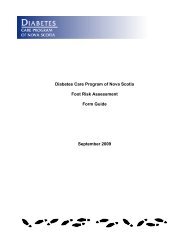2009-10 Annual Report - Central East Local Health Integration ...
2009-10 Annual Report - Central East Local Health Integration ...
2009-10 Annual Report - Central East Local Health Integration ...
You also want an ePaper? Increase the reach of your titles
YUMPU automatically turns print PDFs into web optimized ePapers that Google loves.
Performance Indicator #6<br />
90 th Percentile Wait Times for CT Scan<br />
Aging equipment and increasing complexity of cases is having a negative impact on the ability of CE LHIN<br />
hospitals to meet this performance indicator. Despite individual achievements by specific hospitals, the combined<br />
measurement reflects scans that are taking longer to complete due to complexity, aging machines and increased<br />
referrals from local physicians and the hospitals’ Emergency Departments. An in-year reallocation of surplus<br />
funds from other sectors allowed for an additional 2,707 hours to be provided to four hospitals. The LHIN is<br />
continuing to monitor and resolve the situation.<br />
Performance Indicator #7<br />
Median Wait Time for Long-Term Care Home Placement<br />
The LHIN continues to face challenges in meeting this performance indicator given that improvement involves a<br />
longer term strategy and provincial direction that will impact all LHINs.<br />
With the second highest senior population (>75 years) in the province, the LHIN was successful in having the<br />
highest number of clients placed in February 20<strong>10</strong>, but other factors continue to contribute to longer than<br />
anticipated wait times, including:<br />
7<br />
<br />
<br />
<br />
<br />
<br />
<br />
Socio-demographic nature of residents within LHIN boundaries<br />
Personal choice as per legislation<br />
Cultural preferences for various LTC Homes<br />
Hard to serve populations (e.g. psycho-geriatric patients)<br />
Availability of beds related to demand preference<br />
Resources available at the CE CCAC to support placement<br />
Notwithstanding these problems, the LHIN creatively explored alternative solutions through the provincial Aging<br />
at Home and Emergency Department/Alternate Level of Care strategies. Discussions with the Long-Term Care<br />
sector are also helping to identify options and alternate strategies to deal with ongoing pressures.<br />
Performance Indicator #8<br />
Percentage of Alternate Level of Care (ALC) Days – By LHIN of Institution:<br />
The CE LHIN did not achieve the provincial goal of 9.46% ALC in the <strong>2009</strong>-<strong>10</strong> fiscal year. The new provincial<br />
ALC definition, imposed in July of <strong>2009</strong>, while it helped create consistency across the LHIN and across the<br />
province, also resulted in a spike in ALC numbers, with the LHIN’s performance for the year reaching 18.16%.<br />
Much of the planning for 20<strong>10</strong>-11 involves addressing patient flow through the system and decreasing ALC.<br />
Performance Indicator #9<br />
Proportion of Admitted patients treated within the LOS target of equal to/less than 8 hours<br />
The CE LHIN, like the province, experiences challenges in addressing this indicator. The 90 th percentile average<br />
for the LHIN is 47.81 hours, and the median is 47.65 hours, compared to 30.54 hours and 31.13 for the province,<br />
respectively. For the percent within target indicator, the LHIN’s performance has improved, from a baseline of<br />
32% to an average of 31.24%, and a median of 31%. This measure is related to percentage ALC, and is being<br />
targeted by several initiatives for the 20<strong>10</strong>-11 fiscal year.<br />
Performance Indicator #<strong>10</strong><br />
Proportion of Non-admitted high acuity (CTAS I-III) patients treated within their respective targets of<br />
equal to/less than 8 hours for CTAS I-II and equal to/less than 6 hours for CTAS III.<br />
Despite non-achievement of the target set in the MLAA, the LHIN was pleased that performance improved in this<br />
indicator from an already high baseline of 83% of patients treated within target to an average of 83.74%, and a<br />
median of 84%. Joint efforts with health service providers will continue in 20<strong>10</strong>/11 to meet ongoing targets.

















